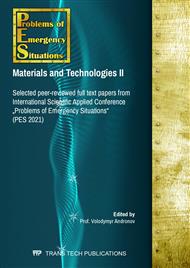[1]
M.E. Gurtin, A.I. Murdoch A continuum theory of elastic material surfaces. Archive of Rational Mechanics Analysis. (1975) 291-323.
DOI: 10.1007/bf00261375
Google Scholar
[2]
V.V. Mykhas'kiv, B.M Stasyuk. Effective elastic properties of 3D composites with short curvilinear fibers: numerical simulation and experimental validation. Solid State Phenomena. 258. (2017) 452-455.
DOI: 10.4028/www.scientific.net/ssp.258.452
Google Scholar
[3]
V.I. Kushch Stress field and effective elastic moduli of periodic spheroidal particle composite with Gurtin-Murdoch interface. International Journal of Engineering Science. 132 (2018) 79-96.
DOI: 10.1016/j.ijengsci.2018.08.001
Google Scholar
[4]
V. Gnitko, K. Degtyariov, A. Karaiev A., E. Strelnikova. Multi-domain boundary element method for axisymmetric problems in potential theory and linear isotropic elasticity. WIT Transactions on Engineering Sciences. 122(2019) 13-25.
DOI: 10.2495/be410021
Google Scholar
[5]
J. Luo, X. Wang. On the anti-plane shear of an elliptic nanoinhomogeneity. European Journal of Mechanics. Solids. 28 (2009) 926-934.
DOI: 10.1016/j.euromechsol.2009.04.001
Google Scholar
[6]
S.G. Mogilevskaya, S.L. Crouch, H.K. Stolarski. Multiple interacting circular nano-inhomogeneities with surface/interface effects. Journal of the Mechanics and Physics of Solids. 56 (2008) 2298-2327.
DOI: 10.1016/j.jmps.2008.01.001
Google Scholar
[7]
L. Tian, R.K. Rajapakse. Elastic field of an isotropic matrix with a nanoscale elliptical inhomogeneity. International Journal of Solids and Structures. 44 (2007) 7988–8005.
DOI: 10.1016/j.ijsolstr.2007.05.019
Google Scholar
[8]
Y.M. Rodichev, N.V. Smetankina, O.M. Shupikov, S.V. Ugrimov. Stress-strain assessment for laminated aircraft cockpit windows at static and dynamic load. Strength of Materials. Vol. 50, no. 6. Springer, US. (2018) 868–873.
DOI: 10.1007/s11223-019-00033-4
Google Scholar
[9]
C.Y. Dong, E. Pan. Boundary element analysis of nanoinhomogeneities of arbitrary shapes with surface and interface effects. Engineering Analysis with Boundary Elements. 35 (2011) 996-1002.
DOI: 10.1016/j.enganabound.2011.03.004
Google Scholar
[10]
Bakr, Adib A., The Boundary Integral Equation Method in Axisymmetric Stress Analysis Problems. Springler – Verlag Berlin Heidelberg New York Tokyo (1986).
Google Scholar
[11]
J. Balas, J. Sladek, V. Sladek. Stress analysis by boundary elements. Studies in Applied Mechanics, Elsevier. (1989).
Google Scholar
[12]
A. Karaiev, E. Strelnikova. Singular Integrals in Axisymmetric Problems of Elastostatics International Journal of Modeling, Simulation, and Scientific Computing. 11(01) (2019) doi.org/10.1142/S1793962320500038.
DOI: 10.1142/s1793962320500038
Google Scholar
[13]
E. Strelnikova D. Kriutchenko, V. Gnitko, K. Degtyarev. Boundary element method in nonlinear sloshing analysis for shells of revolution under longitudinal excitations. Engineering Analysis with Boundary Elements 111 (2020) 78-87.
DOI: 10.1016/j.enganabound.2019.10.008
Google Scholar
[14]
V. Gnitko, K. Degtyariov, V. Naumenko, E. Strelnikova. BEM and FEM analysis of the fluid-structure Interaction in tanks with baffles/ Int. Journal of Computational Methods and Experimental Measurements. 5(3) (2017) 317-328.
DOI: 10.2495/cmem-v5-n3-317-328
Google Scholar
[15]
V. Gnitko, Y. Naumemko, E. Strelnikova. Low Frequency Sloshing Analysis of Cylindrical Containers with Flat and Conical Baffles/ International Journal of Applied Mechanics and Engineering. 22(4) (2017) 867-881.
DOI: 10.1515/ijame-2017-0056
Google Scholar
[16]
O. Strelnikova, V. Gnitko, K. Degtyariov, A. Tonkonozhenko Advanced computational models and software on predicting the effective elastic properties for computer-simulated structures of nanocomposite. IEEE KhPI Week on Advanced Technology (KhPIWeek) (2020) 171-171.
DOI: 10.1109/khpiweek51551.2020.9250093
Google Scholar
[17]
M-T. Le, S-C. Huang. Modeling and Estimating the Effective Elastic Properties of Carbon Nanotube Reinforced Composites by Finite Element Method. J. Eng. Technol. Educ. 11(2) (2014) 145-158.
Google Scholar
[18]
R.E. Miller, V.B. Shenoy. Size-dependent elastic properties of nanosized structural elements Nanotechnology. 11.(2000) 139-147.
DOI: 10.1088/0957-4484/11/3/301
Google Scholar
[19]
W. Gao, S.W. Yu, G.Y. Huang. Finite element characterization of the size dependent mechanical behavior in nanosystems. Nanotechnology. 17 (2006) 1118-1122.
DOI: 10.1088/0957-4484/17/4/045
Google Scholar
[20]
M.Surianinov, V. Andronov, Y. Otrosh, T. Makovkina, S.Vasiukov. Concrete and fiber concrete impact strength. Materials Science Forum. 1006 MSF (2020) 101–106.
DOI: 10.4028/www.scientific.net/msf.1006.101
Google Scholar
[21]
H.H. Tulskyi, L.V. Liashok, H.S. Shevchenko, A.V. Vasilchenko, O.A. Stelmakh. Synthesis of functional nanocomposites based on aluminum oxides. Functional Materials, 26(4) (2019) 718-722.
Google Scholar


